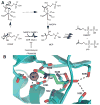Molecular Basis for Resistance Against Phosphonate Antibiotics and Herbicides
- PMID: 26811741
- PMCID: PMC4723106
- DOI: 10.1039/C5MD00351B
Molecular Basis for Resistance Against Phosphonate Antibiotics and Herbicides
Abstract
Research in recent years have illuminated data on the mechanisms and targets of phosphonic acid antibiotics and herbicides, including fosfomycin, glyphosate, fosmidomycin and FR900098. Here we review the current state of knowledge of the structural and biochemical characterization of resistance mechanisms against these bioactive natural products. Advances in the understanding of these resistance determinants have spurred knowledge-based campaigns aimed towards the design of derivatives that retain biological activity but are less prone to tolerance.
Figures





Similar articles
-
Synthesis of beta- and gamma-oxa isosteres of fosmidomycin and FR900098 as antimalarial candidates.Bioorg Med Chem. 2008 Mar 15;16(6):3361-71. doi: 10.1016/j.bmc.2007.12.001. Epub 2007 Dec 8. Bioorg Med Chem. 2008. PMID: 18158249
-
Biochemical bases for a widespread tolerance of cyanobacteria to the phosphonate herbicide glyphosate.Plant Cell Physiol. 2008 Mar;49(3):443-56. doi: 10.1093/pcp/pcn021. Epub 2008 Feb 7. Plant Cell Physiol. 2008. PMID: 18263622
-
Resistance of the Burkholderia cepacia complex to fosmidomycin and fosmidomycin derivatives.Int J Antimicrob Agents. 2011 Sep;38(3):261-4. doi: 10.1016/j.ijantimicag.2011.04.020. Epub 2011 Jul 2. Int J Antimicrob Agents. 2011. PMID: 21724375
-
Biosynthetic pathways and enzymes involved in the production of phosphonic acid natural products.Biosci Biotechnol Biochem. 2021 Jan 7;85(1):42-52. doi: 10.1093/bbb/zbaa052. Biosci Biotechnol Biochem. 2021. PMID: 33577658 Review.
-
The MEP pathway: a new target for the development of herbicides, antibiotics and antimalarial drugs.Curr Pharm Des. 2004;10(19):2391-400. doi: 10.2174/1381612043384006. Curr Pharm Des. 2004. PMID: 15279616 Review.
Cited by
-
Relationship of urinary glyphosate concentrations with glycosylated hemoglobin and diabetes in US adults: a cross-sectional study.BMC Public Health. 2024 Jun 20;24(1):1644. doi: 10.1186/s12889-024-19126-0. BMC Public Health. 2024. PMID: 38902690 Free PMC article.
-
Exploring the diversity and genomics of cultivable Bacillus-related endophytic bacteria from the medicinal plant Galium aparine L.Front Microbiol. 2025 Jun 30;16:1612860. doi: 10.3389/fmicb.2025.1612860. eCollection 2025. Front Microbiol. 2025. PMID: 40661978 Free PMC article.
-
Over 40 Years of Fosmidomycin Drug Research: A Comprehensive Review and Future Opportunities.Pharmaceuticals (Basel). 2022 Dec 14;15(12):1553. doi: 10.3390/ph15121553. Pharmaceuticals (Basel). 2022. PMID: 36559004 Free PMC article. Review.
-
Cyclic di-AMP, a multifaceted regulator of central metabolism and osmolyte homeostasis in Listeria monocytogenes.Microlife. 2023 Jan 28;4:uqad005. doi: 10.1093/femsml/uqad005. eCollection 2023. Microlife. 2023. PMID: 37223746 Free PMC article. Review.
-
Potent, specific MEPicides for treatment of zoonotic staphylococci.PLoS Pathog. 2020 Jun 4;16(6):e1007806. doi: 10.1371/journal.ppat.1007806. eCollection 2020 Jun. PLoS Pathog. 2020. PMID: 32497104 Free PMC article.
References
-
- Hendlin D, Stapley EO, Jackson M, Wallick H, Miller AK, Wolf FJ, Miller TW, Chaiet L, Kahan FM, Foltz EL, Woodruff HB, Mata JM, Hernandez S, Mochales S. Science. 1969;166:122–3. - PubMed
-
- Christensen BG, Leanza WJ, Beattie TR, Patchett AA, Arison BH, Ormond RE, Kuehl FA, Albers-Schonberg G, Jardetzky O. Science. 1969;166:123–125. - PubMed
-
- Kahan FM, Kahan JS, Cassidy PJ, Kropp H. Ann N Y Acad Sci. 1974;235:364–86. - PubMed
-
- Brown ED, Marquardt JL, Lee JP, Walsh CT, Anderson KS. Biochemistry. 1994;33:10638–10645. - PubMed
-
- Eschenburg S, Priestman M, Schönbrunn E. J Biol Chem. 2005;280:3757–3763. - PubMed
Grants and funding
LinkOut - more resources
Full Text Sources
Other Literature Sources

